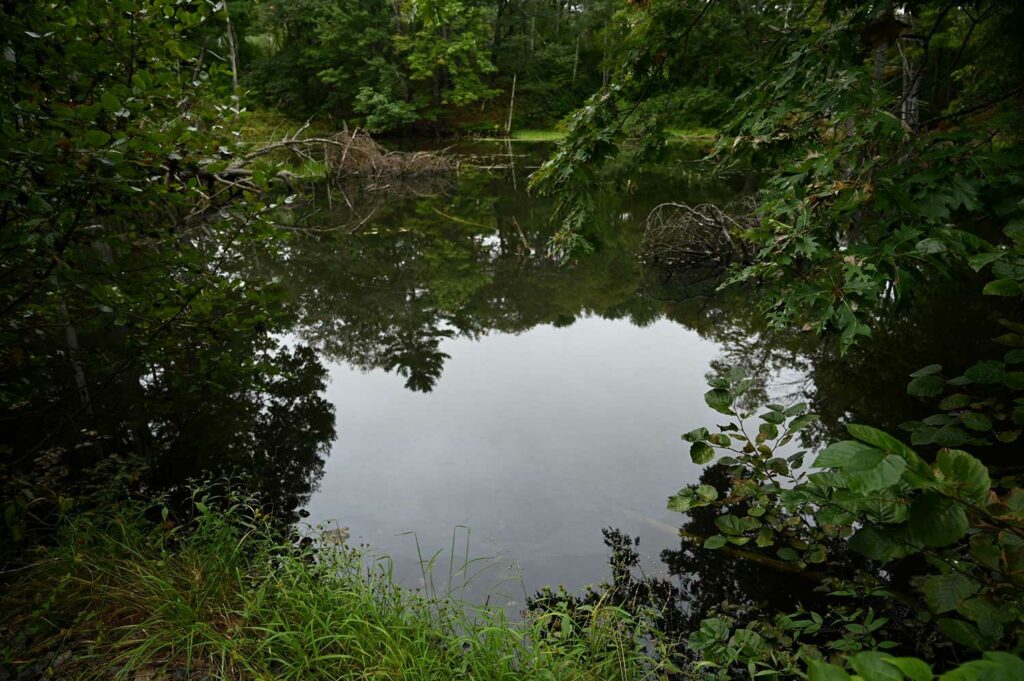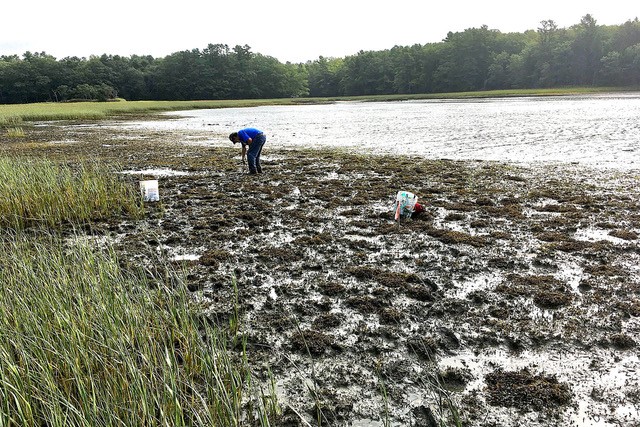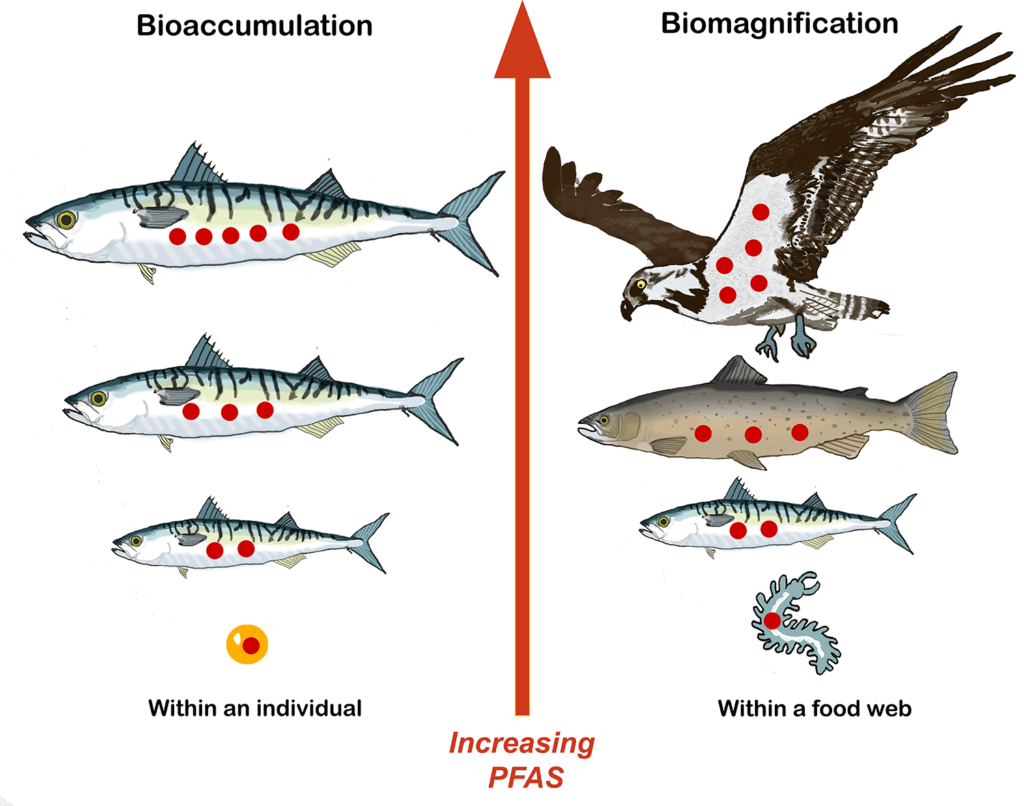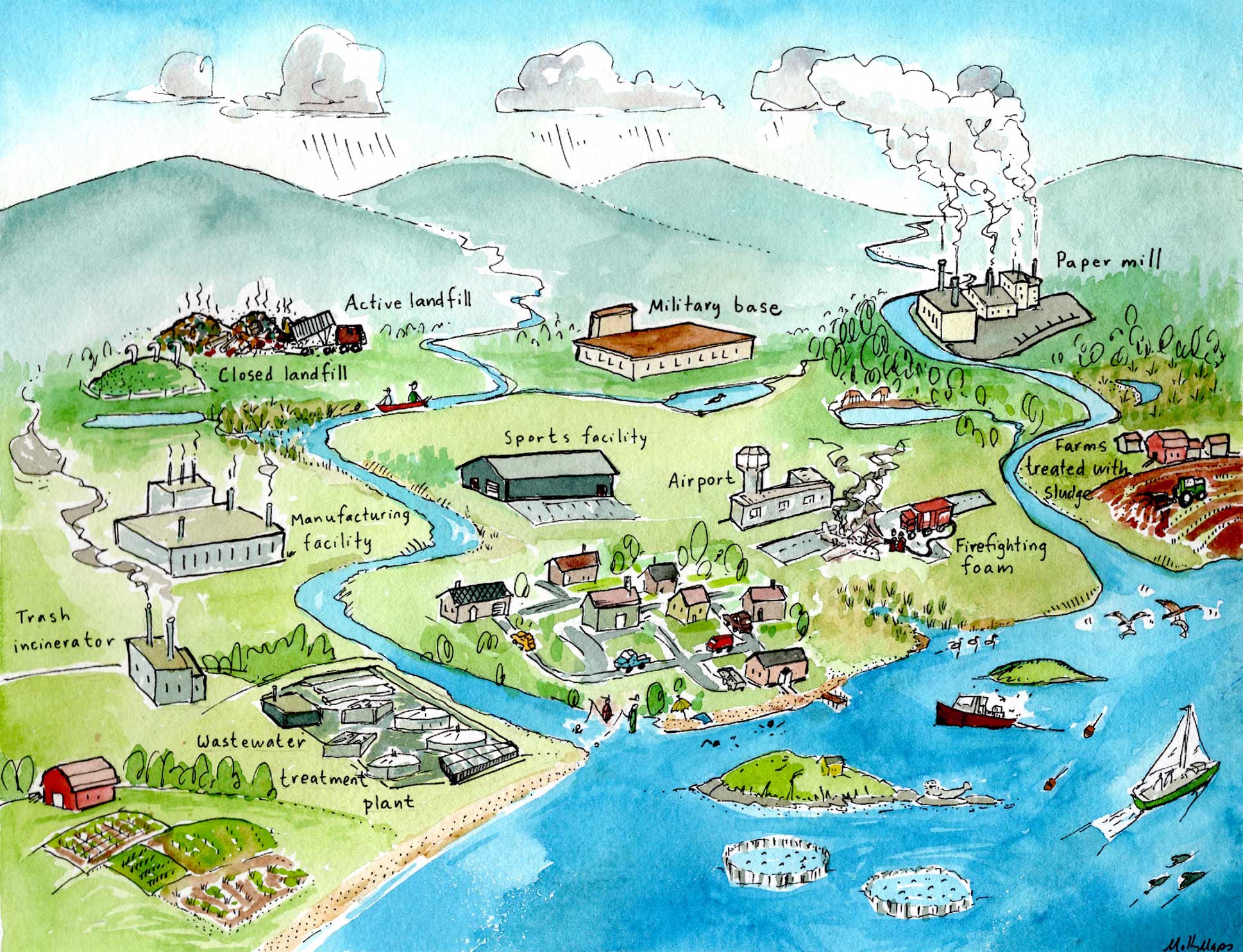Testing the Waters
Tracing the movement of PFAS into waterways and wildlife
Martha Spiess, a retired veterinarian, began testing waters in Brunswick for PFAS (per- and polyfluoroalkyl substances) after hearing news of ‘forever chemicals’ contaminating Maine farms. “It felt like tragedy was falling all around me,” she said.
Spiess first encountered PFAS while growing up in Minnesota where her father, an organic chemist, worked for 3M, a major PFAS manufacturer. In the late 1960s, she recalled, her family received a gift box filled with 3M product samples. As she unpacked the items, her father grabbed the can of Scotchgard (a water-repellent spray with PFAS) and told her, “Don’t you ever use this!”
The dangers of fluorinated compounds were apparent then, Spiess said. “It was something he knew, the lab knew, and I think the company knew. He was angry that they were marketing that,” she said.
Now Spiess tests waters around the former Brunswick Naval Air Station, looking for evidence of another product with PFAS called AFFF (aqueous film-forming foam, or “A-triple-F”) that 3M manufactured from the 1960s until 2000.
For decades, hundreds of military bases and airports, and thousands of fire departments across the country used AFFF in training exercises and to combat fires involving combustible liquids. The highly mobile PFAS in the firefighting foam entered groundwater and surface water in many settings, contaminating private wells and public water supplies. A growing body of research shows that PFAS can disrupt hormonal, immune and reproductive systems, and can increase the risk of various cancers.

Sampling done in December 2021 at Pond 3 along the northern side of the Brunswick Naval Air Station showed a marked increase in two PFAS compounds, with the level of one more than doubling over the number recorded three years earlier by the state. Photo by Marina Schauffler.
When the Brunswick & Topsham Water District discovered PFAS chemicals in its well field near the former base, Spiess was not surprised. Water sampling at sites around the former air station had already shown upticks in PFAS levels compared to previous data at those locations.
‘There are no clean samples’
Being highly mobile and more water soluble than traditional pollutants, “PFAS distribute mainly through rivers and groundwater,” said Christoph Aeppli, a senior research scientist with Bigelow Laboratory for Ocean Sciences in East Boothbay. He is testing blue mussels for 30 PFAS, part of a project to assess how the chemicals move through marine food webs and how long they reside in shellfish. It’s already clear, he said, that many PFAS are “taken up by quite a lot of marine organisms, bottom-dwelling ones and those in the water column.”
Downstream of where Spiess gathers samples from Mere Brook by the former Naval Air Station, David Page, a retired Bowdoin College biochemistry professor, has tested ribbed mussels for PFAS where that brook empties into the tidal waters of Harpswell Cove. Because mussels remain in one place and filter large volumes of water, they “can be used to understand potential human exposure to contaminants,” Maine Department of Environmental Protection (DEP) biologists wrote in a 2016 report. Mussels can concentrate chemicals, allowing scientists to detect contaminants that might otherwise be below detection limits, the report noted.

Sampling of mussels being conducted in 2020 in upper Harpswell Cove, near a brook that flows from the Brunswick Naval Air Station. Photo courtesy of David Page.
In a 2020 mussel sampling, Page found that PFOS, a PFAS compound associated with AFFF use, was highest in ribbed mussels near the head of the cove closest to the former base, indicating that deposits are continuing to run off and “reach biological communities downstream of the facility,” Page wrote. The levels he found were higher than those in blue mussels the state sampled farther out of the cove in 2014 and 2016.
A recent analysis of mussels throughout the Gulf of Maine done for NOAA’s National Centers for Coastal Ocean Science found one PFAS compound, PFOSA, at 40 percent of the sample sites.
Unlike pollutants like PCBs or DDT that accumulate within fatty tissue, PFAS are drawn to proteins, fluids and organs, said Diane Kopec, a fellow at the University of Maine’s Mitchell Center for Sustainability Studies. Since wildlife higher up the aquatic food web eat most parts of their prey, they can accumulate greater concentrations of PFAS.
PFAS compounds, which number in the thousands, differ markedly in how they’re absorbed and stored within bodies. Those chemicals with longer eight-carbon chains (like PFOA and PFOS, which are no longer manufactured but still created and prevalent in the environment), tend to concentrate in wildlife through ingestion of prey, Kopec noted, while newer, shorter-chain PFAS can move directly from the water column into fish through their gills.
“PFAS are toxic enough that low levels can have negative impacts, but some of those effects can be especially hard to track in wildlife,” said Anna Robuck, an environmental chemist whose doctoral research focused on PFAS in marine food webs. (She spoke as an adjunct professor at the University of Rhode Island, not in her current role with the federal government.)
Organisms at the bottom end of the marine food web, like shellfish and plankton, appear to have lower accumulations, but the species that feed on those organisms — such as birds — “are full of PFAS,” Robuck said. “We see a much different pattern. Air-breathing organisms are more vulnerable to (PFAS) bioaccumulation and biomagnification.”

Contaminants like PFAS build up within individual organisms over time (bioaccumulation) and become more concentrated in animals higher up the food web (biomagnification). Illustration by Bennet Geis.
In research spanning seven years, Robuck has looked at PFAS in Gulf of Maine water, sediments, plankton, coastal and offshore seabirds, and humpback whale tissue. “There is no species that did not have PFAS in them,” she said. “There are no clean samples.”
Rachel Rice, a graduate student at College of the Atlantic in Bar Harbor, is analyzing the presence of 43 PFAS in seven marine mammal species, assessing the feeding habits of each species and sampling diverse tissues. Rice’s study will report on PFAS levels in seawater, plankton, fish and lobster, and will compare current levels in seals to a baseline set 13 years ago.
In 2009, long before the recent public spotlight on PFAS, researchers at the Shaw Institute in Blue Hill studied the accumulation of fluorinated compounds in harbor seals, writing that they found evidence of “diffuse sources of perfluorochemical contamination throughout the northwest Atlantic.”
Given the “concerted inputs of PFAS” from waterways entering the Gulf of Maine and the long residence time of its waters, Robuck expects that Rice will find high levels. Seals feed at the upper reaches of the marine food web, she said, which is “at the end of the day, where we’re eating.”
‘A boomerang effect’
“Every contaminant ends up in water,” Kopec said, and “water always flows downhill. It’s all moving down to the ocean.” Many scientists assumed that oceans would become the ultimate sink for PFAS, with compounds cycling through marine ecosystems and settling into bottom sediments over decades.
But last year, researchers at Stockholm University reported on what they termed a “boomerang effect,” where PFAS return to land in the form of sea spray, carried through the atmosphere and falling again on soils and waters.
The cycling of PFAS from surface environments into the atmosphere is something Stockholm University scientists have tracked for a decade. Last month they shared new data showing that rainfall around the globe contains PFAS, often at levels higher than the newly revised U.S. “drinking water health advisory level” for two common PFAS compounds. Just as toxicological research is pushing thresholds for safe exposure closer to zero, the ubiquity of PFAS in water systems worldwide is becoming clear.
That poignant juxtaposition inspires Martha Spiess to keep sampling local waters, hoping others will start testing wells and waterways. On a September morning, she returned to Mere Brook and took a sample that lab analysis later showed had 18 PFAS with a total concentration of 1,291 parts per trillion. “PFAS are there,” she said. “Why are we waiting?”
This project was produced with support from the Doris O’Donnell Innovations in Investigative Journalism Fellowship, awarded by the Center for Media Innovation at Point Park University in Pittsburgh, Pa.
© Marina Schauffler, 2022. All Rights Reserved. Reprints available upon request
The need for affordable PFAS water testing
When members of the regional watershed group Friends of Merrymeeting Bay (FOMB) learned about a relatively affordable PFAS water-testing kit made by the Illinois company Cyclopure, they envisioned using it to screen waters in the six rivers that feed the bay. To ensure credible results, the group’s chair, Ed Friedman, organized what he termed a “Consumer Reports-style comparison,” sending split samples from a single water source to Cyclopure, and to three labs accredited by state and federal agencies.
FOMB found that the Cyclopure kit, which uses a corn-based disk designed to extract PFAS from water, delivered comparable results to two of the accredited labs in a similar time frame (a week or two) at substantial cost savings; each kit costs less than $80 rather than between $400 and $700. (The third accredited lab failed to detect many compounds the other labs had and took more than a month to deliver results.)
PFAS Free Trenton, a citizen’s group that recently persuaded the town’s select board to approve purchasing 100 test kits for residents, chose to test with accredited labs despite the added cost, said its spokesperson, Christina Heiniger, because those tests are the only ones recognized by the state.
“DEP uses only lab-accredited processes because sampling results need to be reliable, consistent and replicable to the greatest extent possible,” the agency’s spokesperson David Madore wrote. “This is critically important as DEP makes both policy and funding decisions based upon the results obtained.”
“FOMB’s analysis and validation of the Cyclopure methodology challenges DEP’s argument and policy,” Friedman noted, adding that for the many homeowners who don’t know in advance if they will receive a state reimbursement for water-testing, the “high price of certified testing is a huge disincentive.”
Bob Bowcock, a national water consultant who is collaborating with the activist Erin Brockovich to help Maine communities address PFAS contamination, sees screening tests as a means of triage given “we’ve got an emergency on our hands,” he said. He has four full-time assistants working in Maine to locate contamination hot spots, doing preliminary screening “where you can get five test kits for the price of (an accredited) one.”
“The state could screen so many more people so much more quickly,” Bowcock added, “if they just looked at alternative strategies.”
“Every contaminant ends up in water… It’s all moving down to the ocean,” said Dianne Kopec, a fellow at the University of Maine’s Mitchell Center for Sustainability Studies. Illustration by MollyMaps. Licensed under Creative Commons.


